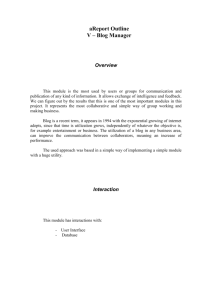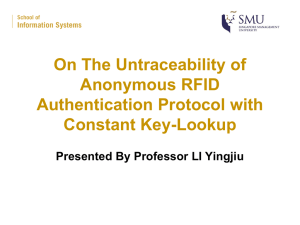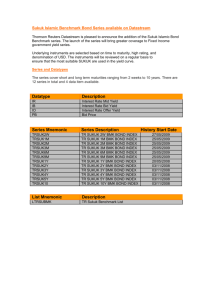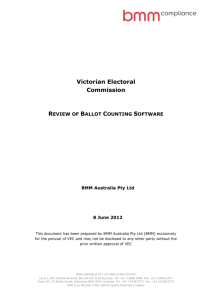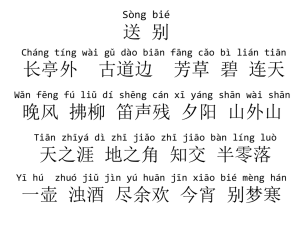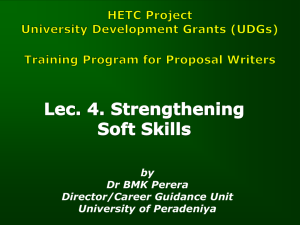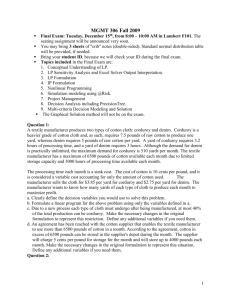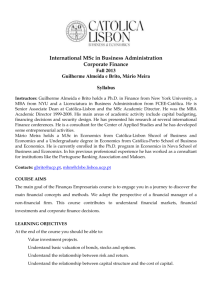Market Research for Microfinance Opportunities
advertisement
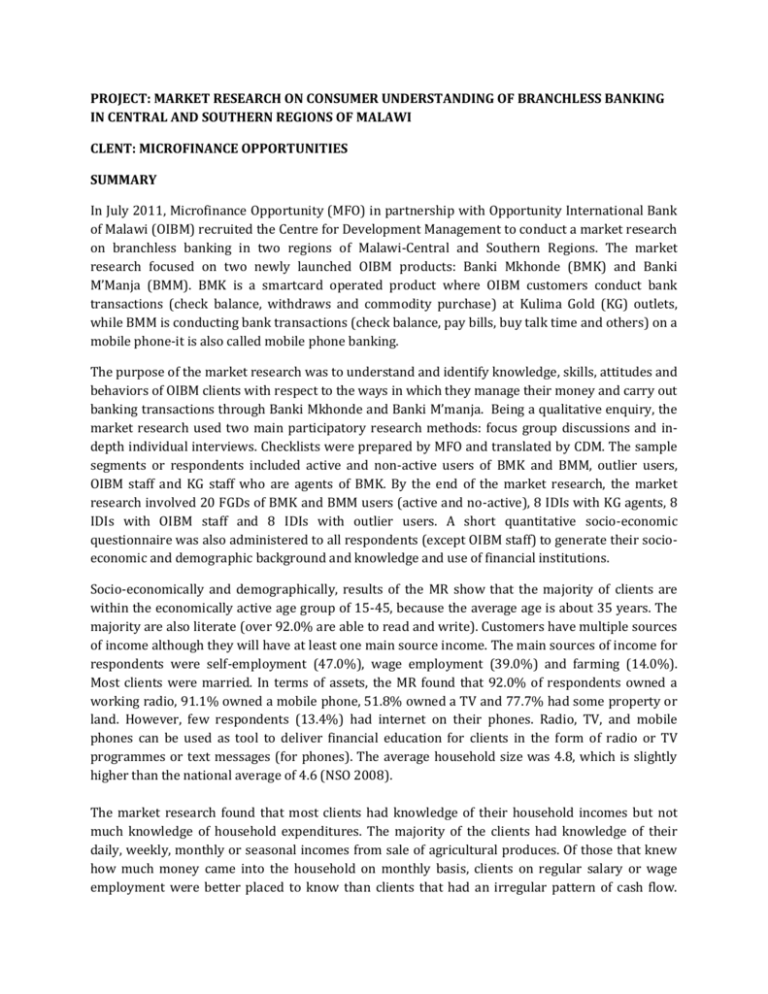
PROJECT: MARKET RESEARCH ON CONSUMER UNDERSTANDING OF BRANCHLESS BANKING IN CENTRAL AND SOUTHERN REGIONS OF MALAWI CLENT: MICROFINANCE OPPORTUNITIES SUMMARY In July 2011, Microfinance Opportunity (MFO) in partnership with Opportunity International Bank of Malawi (OIBM) recruited the Centre for Development Management to conduct a market research on branchless banking in two regions of Malawi-Central and Southern Regions. The market research focused on two newly launched OIBM products: Banki Mkhonde (BMK) and Banki M’Manja (BMM). BMK is a smartcard operated product where OIBM customers conduct bank transactions (check balance, withdraws and commodity purchase) at Kulima Gold (KG) outlets, while BMM is conducting bank transactions (check balance, pay bills, buy talk time and others) on a mobile phone-it is also called mobile phone banking. The purpose of the market research was to understand and identify knowledge, skills, attitudes and behaviors of OIBM clients with respect to the ways in which they manage their money and carry out banking transactions through Banki Mkhonde and Banki M’manja. Being a qualitative enquiry, the market research used two main participatory research methods: focus group discussions and indepth individual interviews. Checklists were prepared by MFO and translated by CDM. The sample segments or respondents included active and non-active users of BMK and BMM, outlier users, OIBM staff and KG staff who are agents of BMK. By the end of the market research, the market research involved 20 FGDs of BMK and BMM users (active and no-active), 8 IDIs with KG agents, 8 IDIs with OIBM staff and 8 IDIs with outlier users. A short quantitative socio-economic questionnaire was also administered to all respondents (except OIBM staff) to generate their socioeconomic and demographic background and knowledge and use of financial institutions. Socio-economically and demographically, results of the MR show that the majority of clients are within the economically active age group of 15-45, because the average age is about 35 years. The majority are also literate (over 92.0% are able to read and write). Customers have multiple sources of income although they will have at least one main source income. The main sources of income for respondents were self-employment (47.0%), wage employment (39.0%) and farming (14.0%). Most clients were married. In terms of assets, the MR found that 92.0% of respondents owned a working radio, 91.1% owned a mobile phone, 51.8% owned a TV and 77.7% had some property or land. However, few respondents (13.4%) had internet on their phones. Radio, TV, and mobile phones can be used as tool to deliver financial education for clients in the form of radio or TV programmes or text messages (for phones). The average household size was 4.8, which is slightly higher than the national average of 4.6 (NSO 2008). The market research found that most clients had knowledge of their household incomes but not much knowledge of household expenditures. The majority of the clients had knowledge of their daily, weekly, monthly or seasonal incomes from sale of agricultural produces. Of those that knew how much money came into the household on monthly basis, clients on regular salary or wage employment were better placed to know than clients that had an irregular pattern of cash flow. Generally, record keeping of incomes and expenses was uncommon practice amongst all the clients with no exception of outliers. The MR revealed that the majority of the clients, BMM and BMK active and non-active users did not set limits to the amount they would expend every week or month. In terms on knowledge and use of the products, the majority most of the clients interviewed in the market research had heard what BMK and BMM are about. The main reason for all of them having knowledge of the products might have been that all of them were OIBM clients, both as active and non-active users of the two products. The main sources of information for the two products were OIBM, radio and posters. When asked about what they knew about BMK and BMM, most of them understood the two products correctly, but in a narrow sense1: BMK as a way of withdrawing money from Kulima Gold while BMM was explained as a way of checking your balance of the account using the phone. Both BMK and BMM are being used and appreciated by customers, although all respondents interviewed reported that knowledge about the two products is limited for most of OIBM customers not included in the sample. For BMK, KG agents were oriented on how to operate the POS machine, but the training was not adequate and did not involve all staff members that are currently using the POS machine. For BMM, only members of staff of OIBM were oriented on how the product works and the services it offers. Clients who had some form of official information from OIBM got it at the time of registration or from posters in banking halls or during the launch of the product. The commonly used BMK services are cash withdrawals and checking balance, while those for BMM is checking balance. With BMK, checking balance is usually conducted alongside a withdrawal-client do not just check balance-they withdrawal as soon as the account has money. The most used service for BMM was checking balance. Checking balance was also the only service which was functioning for BMM during the period of the market research for the majority of clients the team interviewed. The number of transactions for each product depended on the location, (whether rural or urban), proximity to an OIBM fixed outlet and the time/week of the month. The MRT found that in Lilongwe, KG outlets based in rural areas served more BMK customers per day than those located in urban areas. In Blantyre, there was not much difference between rural and urban areas, although urban areas had slightly more BMK customers. Both BMK and BMM served rural communities more than urban communities-because of rural areas have to travel long distances to access OIBM outlets. BMK transactions conducted in urban areas were reported to be done by customers who travel from rural areas to do business in town. KG outlets in Blantyre had more customers of BMK per day than in Lilongwe, regardless of rural or urban location. One reason for the difference may be that in general Blantyre is a more commercially oriented City than Lilongwe, which dominated by the agricultural industry. Further, the MRT noted that in the Southern Region, OIBM staff performed more supervisory and monitoring visits to agents than in Lilongwe, although the visits were still not that systematic and institutionalized. This seems to encourage agents to be more proactive. Amongst the main reasons why clients enrolled for BMK and BMM are speed, proximity and convenience, security, cost and time-saving. For example, for customers close to an OIBM fixed 1 Narrow in the sense that they defined the products only the main service that they used. outlets, Banki Mkhonde has expanded banking hours from 38 to 54 hours a week, an improvement of 42.0%. For clients living far from OIBM outlets, BMK has introduced banking services available 54 hours a week. For BMM checking balance can be done any-time at home, as long as network is available. The MR found that the main challenges of both products at the moment are the limited understanding of the two products and the unreliable network. For BMK, there are also operational challenges such as POS machine breakdowns, shortage of paper rolls, shortage of cash at KG outlets, while for BMM the operational challenges are that clients do not know how to use their phones adequately, phones running out of battery and availability of airtime for checking balance. For recommended training materials, the MR found that most clients (both for BMK and BMM), preferred to learn through posters and flip book. The main criteria for choice of learning materials were visibility, simplicity, level of detail, how materials are illustrated, portability and storability, size and weight of the materials and ability to show benefits of a product. The MR has made recommendations in two key areas: those that could be addressed by the financial education project and those that should be addressed by OIBM in their regular work. The summary recommendations are: 1. That OIBM should use the FE project to create awareness and increase uptake of BMK and BMM 2. To strengthen the capacity of BMK agents so that they are able to provide high quality BMK services 3. Ensure that all BMM services are functional since the uptake of Banki M’manja service will, to a greater extent, depend on the availability of other service range other than checking account balance. 4. The need to strengthen tailor-made training programmes for different market segments, using community-based participatory and gender sensitive approaches 5. Strengthen partnerships with network providers, especially Malswitch, Airtel and TNM. 6. Need for OIBM to explore feasibility of new BMK partners, especially chain stores to address shopping needs of BMK urban customers 7. Need for OIBM to hasten arrangements with RBM to license collection of deposit at KG BMK should also collect deposits Recommendations bullets 1 to 4 can be addressed by the proposed Financial Education Project while 5 to 7 should be addressed by OIBM in their regular work.
